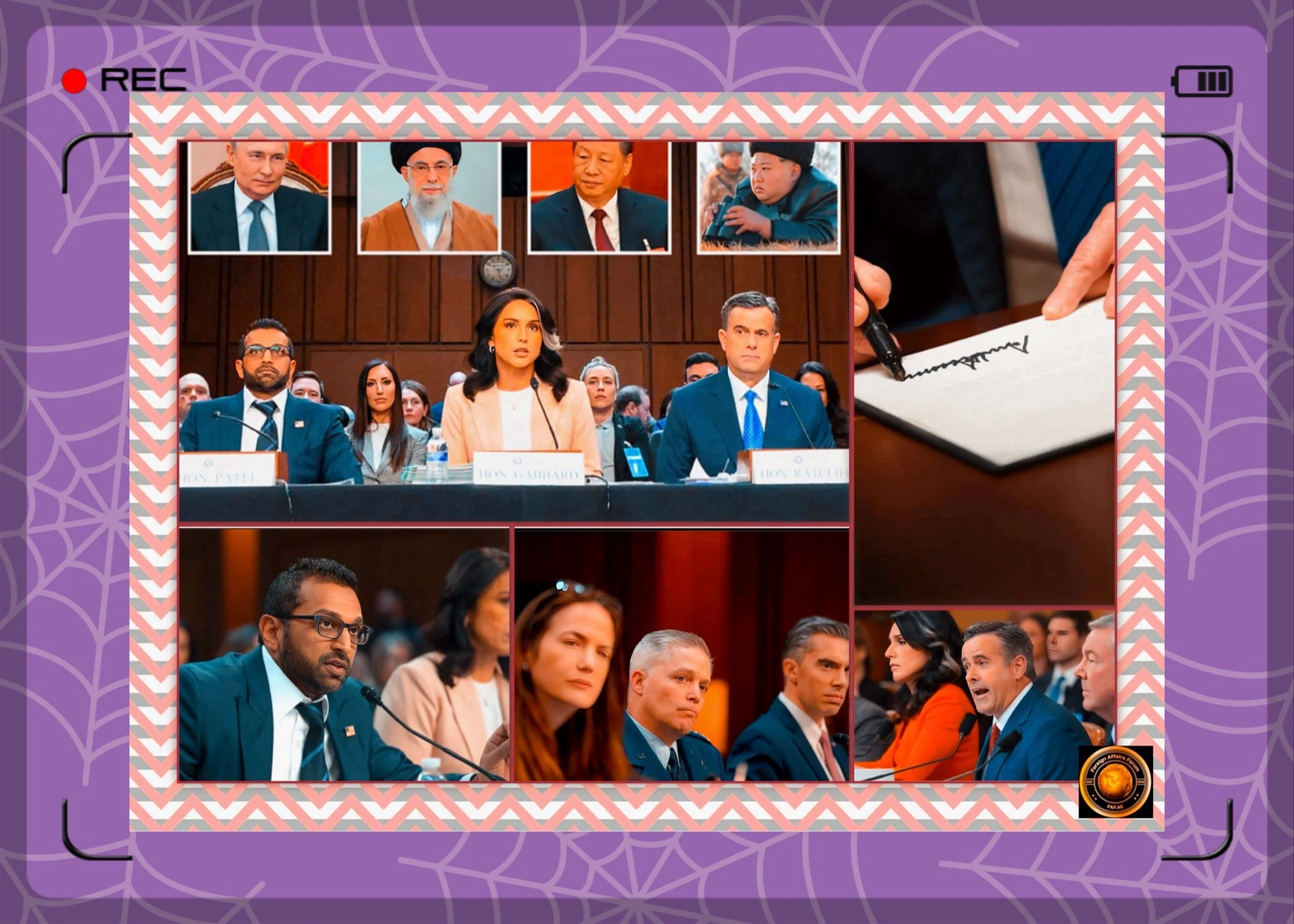US Intelligence Assessment 2025: CRINK Coalition and Global Strategic Threats
Introduction
In the March 25, 2025, Senate Intelligence Committee hearing, US intelligence leaders presented their Annual Threat Assessment, highlighting unprecedented challenges from a growing coalition of adversaries while raising concerns about European security amid shifting American commitments.
The Office of the Director of National Intelligence’s (ODNI) 30-page report and subsequent testimony by DNI Tulsi Gabbard, CIA Director John Ratcliffe, and other intelligence chiefs painted a complex picture of evolving global threats that could fundamentally reshape America’s security landscape.
The CRINK Coalition
A New Axis of Adversaries
The intelligence community identified an emerging coalition of four significant adversaries—China, Russia, Iran, and North Korea (sometimes referenced as “CRINK”)—who are increasingly collaborating to undermine U.S. interests globally.
While described as “uneven” and primarily driven by a shared interest in diminishing U.S. power, this alignment presents a qualitatively different challenge than these nations posed individually.
“The threats we face are genuinely existential,” stated Senate Intelligence Committee Chairman Tom Cotton during the hearing, highlighting the gravity of this new alignment.
The collaboration among these adversaries is particularly evident in the Ukraine conflict, where China provides economic and security support to Russia’s military efforts, Iran supplies drones, and North Korea contributes munitions, missiles, and troops.
While these relationships have practical limitations and are tempered by each nation’s desire to “manage escalation,” intelligence officials expressed concern that this coalition creates “a vastly more complex and dangerous security environment.”
The partnership between China and Russia was identified as the most significant and “persistent” threat to the U.S. within this coalition.
China
America’s “Most Capable Strategic Competitor”
The intelligence assessment unambiguously identified China as “the most capable actor” and “most comprehensive and formidable military threat” to U.S. national security.
DNI Gabbard directly told the Senate hearing that, according to current intelligence assessments, “China is our most capable strategic competitor.”
The report described China as deploying “intricate, comprehensive campaigns” using coercive military, economic, and influence tactics to reinforce its positions globally.
However, unlike other adversaries, China was characterized as more “cautious” in its approach, seeking to protect its economic and diplomatic standing worldwide.
China’s technological advancements received particular attention. The intelligence community warned that Beijing is pursuing a “multifaceted, national-level strategy” to displace the United States as the world’s most influential AI power by 2030.
China’s aggressive whole-of-government approach combines the state's direction with the private sector to achieve technological dominance in fields such as AI, quantum information science, and semiconductors.
Of immediate concern is China’s cyber threat capability. The report labeled China “the most active and persistent cyber threat” to the U.S. government, private sector, and critical infrastructure networks.
Specifically mentioned were China’s “Volt Typhoon” campaign to preposition access to critical infrastructure and the “Salt Typhoon” compromise of U.S. telecommunications infrastructure, which demonstrated “the growing breadth and depth of the PRC’s capabilities.”
Taiwan and Regional Tensions
The intelligence assessment warned that Beijing will likely intensify its coercive measures against Taiwan by 2025 in pursuit of unification.
The report also highlighted China’s assertive claims in the South and East China Seas against U.S. allies like Japan and the Philippines.
Intelligence officials suggested that Beijing is striving to position itself advantageously in a potential conflict with the United States, with its military operations over Taiwan and sovereignty claims in regional seas occurring routinely in ways that increase the risk of miscalculations potentially leading to conflict.
Russia’s Evolving Threat Posture
The intelligence assessment portrayed Russia as a persistent and multifaceted threat, with DNI Gabbard noting that the country is rapidly modernizing its nuclear arsenal to evade U.S. missile defenses.
The report characterized Russia’s perspective on the Ukraine conflict as a “proxy war” against the West, with President Vladimir Putin showing no inclination toward de-escalation.
CIA Director Ratcliffe offered a sobering assessment of the situation in Ukraine, asserting that “Russia possesses the battlefield advantage and is slowly advancing.”
The intelligence community believes that Putin appears “determined and willing to incur significant costs” to achieve what he considers a pivotal moment in Russia’s strategic rivalry with the West.
The assessment paid significant attention to Russia’s cyber capabilities. The report described Russia’s “advanced cyber capabilities” and “practical experience” integrating cyber attacks with wartime military action as uniquely dangerous.
The report noted that Russia has demonstrated “real-world disruptive capabilities during the past decade,” particularly by targeting Ukraine’s networks with disruptive and destructive malware.
The assessment also warned about Russia’s space warfare capabilities, noting that it “continues to train its military space elements and field new anti-satellite weapons” designed to disrupt and degrade U.S. and allied space capabilities.
North Korea’s Strategic Evolution
The intelligence assessment highlighted North Korea’s growing strategic capabilities and deepening relationship with Russia.
According to DNI Gabbard, North Korea’s strengthening ties with Russia have reduced its reliance on China and acquired enhanced strategic capabilities.
The report revealed that North Korea has sent munitions, missiles, and “thousands of combat troops” to Russia to support its war against Ukraine.
This military support was characterized as fulfilling commitments made in the “Treaty on Comprehensive Strategic Partnership” announced between Pyongyang and Moscow in June 2024.
Beyond conventional military support, the assessment warned that North Korea is funding its military development by “stealing hundreds of millions of dollars per year in cryptocurrency” from the United States and other victims.
It further cautioned that North Korea may expand its cyber espionage activities to fill gaps in its weapons programs, potentially targeting defense industrial base companies involved in aerospace, submarine, or hypersonic glide technologies.
European Security and Nuclear Proliferation Concerns
A deeply concerning aspect of the intelligence assessment involved the potential for nuclear proliferation among traditional U.S. allies in Europe.
Intelligence leaders warned that America’s shifting posture toward European defense is pushing key allies toward dangerous new strategies—including potentially pursuing their own nuclear weapons programs.
The testimony revealed that the perception of a waning American security umbrella, combined with Russia’s aggressive actions in Ukraine and widespread sabotage campaigns across Europe, has led European leaders to question long-standing security arrangements.
Senator John Cornyn (R-TX) noted during the hearing that “the incoming chancellor of Germany has talked about the possibility that Germany might share its nuclear weapons with Ukraine” and that “Poland has talked about acquiring nuclear weapons.”
Defense Intelligence Agency Director Lieutenant General Jeffrey Kruse confirmed these developments would “make the world a more dangerous place” as additional countries developing their deterrence policies would complicate the nuclear environment.
The assessment suggested that Europe’s potential nuclear trajectory represents a dramatic departure from post-Cold War norms that could fundamentally alter global security dynamics.
Implications for U.S. National Security
The intelligence assessment’s findings present profound implications for U.S. national security strategy. The emergence of a coordinated coalition of adversaries requires a more sophisticated and comprehensive response than dealing with each nation individually.
The warning that “these threats reinforce each other, creating a vastly more complex and dangerous security environment” underscores the need for integrated countermeasures.
China’s technological advancement trajectory, particularly in artificial intelligence, represents a fundamental challenge to traditional U.S. technological superiority.
The assessment’s warning that China could displace the United States as the preeminent AI power by 2030 suggests a narrowing window for maintaining America’s edge in this critical domain.
Perhaps most concerning is the potential unraveling traditional nuclear non-proliferation norms among U.S. allies.
General Kruse testified that the emergence of additional nuclear powers with independent deterrence policies would “complicate all of the decisions” that define future conflicts.
This suggests that a strategic withdrawal from European security commitments could create more unpredictable and dangerous security dynamics that directly impact U.S. interests.
Conclusion
The 2025 intelligence assessment portrays a world at a critical inflection point in global security affairs.
The unprecedented collaboration among China, Russia, Iran, and North Korea represents a qualitative shift in the threat landscape facing the United States.
Simultaneously, the potential nuclear proliferation among traditional allies suggests that the post-Cold War security architecture is increasingly unstable.
Senator Tom Cotton remarked during the hearing many of these threats are “genuinely existential.”
The assessment's frank acknowledgment that U.S. intelligence agencies may not be adequately prepared to confront these threats highlights the urgency of strategic adaptation.
As the world enters what intelligence officials characterized as a “precarious phase of instability,” America’s response to these interconnected challenges will likely define the global security environment for decades.






